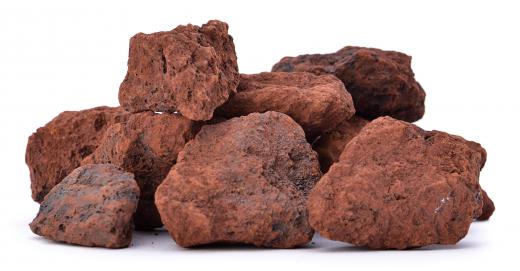The process of pig iron production involves the combination of iron ore, charcoal, and an intermediary material known as a flux inside a blast furnace. As the materials combine with intense heat, much of the iron ore melts, creating a superheated, liquid form. Depending on the materials and cooling method used, pig iron production can be an intermediary step in the creation of wrought iron, cast iron, or steel.
A blast furnace used for pig iron production is usually a large steel structure with several openings. Near the top, openings allow the addition of the ore, charcoal, and flux materials in an alternating pattern. Lower down on the furnace, two doors allow the injection of air, which is pre-heated to anywhere between 1472-2192 degrees Fahrenheit (800-1200 degrees Celsius). At the very bottom of the blast furnace, two additional openings allow the liquid metal and slag to be drained away.

Once inside the furnace, the materials undergo several reactions that allows the creation of liquid pig iron. The charcoal releases carbon monoxide, which amplifies the heat from the air, raising the temperature to even higher levels. As the carbon monoxide rises, it reduces the amount of iron oxide in the iron layers, leaving a higher percentage of pure metallic iron and reducing the melting point of the ore. The flux material, which is usually either limestone or feldspar, reacts with impurities in the iron ore, creating a low-melting point material known as slag and further purifying the ore. Once these crucial interactions have taken place, the iron melts and is drained out through the bottom of the furnace.

The next step in pig iron production involves the cooling of the material, and also explains the unusual name of the product. As the liquid iron drains out of the furnace, it is traditionally diverted into a long, central channel with many shorter channels set off at angles, where it cools and hardens. The name “pig iron” comes from the resemblance of the long channel to a mother pig, and the smaller channels to suckling piglets. In most modern pig iron production, however, this process is no longer used, as methods have been developed that allow the pig iron to be transported in a liquid state, rather than as a hard material.
Pig iron production is generally only one step in the creation of a finished iron product, since the high carbon content of iron in this form makes it mostly unusable. To make it more versatile, it can be melted again and mixed with slag, creating wrought iron, or combined with additional iron ore and alloys to create cast iron. Most often, pig iron production is an intermediary step on the road to creating steel, which involves a second burning process to remove many of the remaining impurities, and the addition of other metals to create an iron-based alloy.
